Warning: Clutch wear dust may contain asbestos, which is very hazardous to health. Do not blow off dust with compressed air and do not inhale air containing asbestos. Use a respirator. DO NOT clean dust with gasoline (or gasoline-based solvents). Use brake fluid or methyl alcohol. After cleaning the components, place the used rags in an airtight labeled container.
Withdrawal
1. There are two options for accessing the clutch pedal. First: remove the power block (chapter 2B) and separate the transmission from the engine on a workbench. Second: remove the transmission without removing the engine from the car (chapter 7A or 7B). In the second method, please note that in order to remove the transmission, it must be moved to the left in the engine compartment (see fig. 7.1).
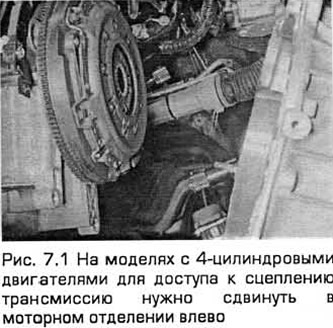
2. After separating the transmission from the engine, check for alignment marks on the clutch cover and flywheel. If there are no such marks, apply them by dripping paint or using a scriber (see fig. 7.2). These marks will be needed if the cover is reinstalled. This will also help keep the node balanced. The new cover can be installed in any position that the pins allow.
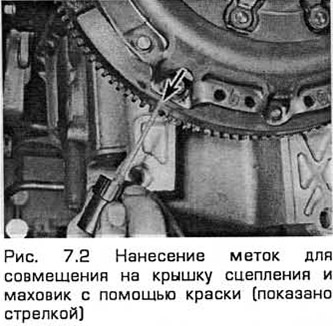
3. Turn out six bolts of fastening of a cover of coupling. Loosen bolts in a criss-cross pattern one turn at a time (see fig. 7.3). If necessary, the flywheel can be blocked with a screwdriver. To do this, insert it into the teeth and rest it on the cylinder block.
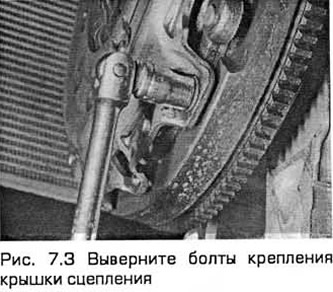
4. Remove the clutch cover from the dowel pins. Prepare to catch the friction disc that falls out when the cover is removed (see fig. 7.4). Pay attention to which side the disk is installed.
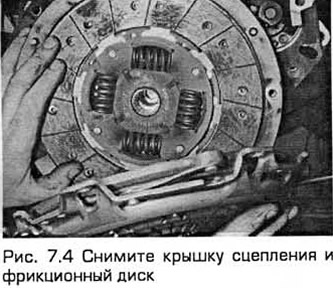
Inspection
5. Most often, clutch failure is due to wear on the friction disc. But it is still necessary to inspect all clutch components, especially if the car has a high mileage. Regardless of the components appearing to be serviceable, it is recommended to replace them as a set (friction disc, pressure plate and release bearing). Replacing only a worn friction plate does not always work, especially if the old plate is sticking, causing the pressure plate to overheat.
6. Inspect the friction disc for worn linings, loose rivets, cracks, warping of the disc, worn splines, and broken damping springs (in the presence of). The surfaces of the overlays may be shiny, but this is acceptable as long as they look clean. The distance from the surfaces of the linings to the heads of the rivets must be at least 1 mm.
7. If the lining surfaces are contaminated with oil, which appears as spots or a solid discoloration to shiny black, then the disc must be replaced. Locate and eliminate sources of contamination before installing new clutch parts. Usually the cause of contamination can be leaks from the rear crankshaft seal (contact your dealer for replacement) or transmission input shaft seals (see chapter 2, replacement). The disc also needs to be replaced when the pads are worn to the level of the rivet heads.
8. Inspect the machined surfaces of the flywheel and pressure plate. If there are grooves or deep scratches on them, replace the corresponding part. The pressure plate must also be replaced if it is cracked, if the diaphragm spring is damaged or its force changes.
9. While the gearbox is removed, it is recommended to check the condition of the release bearing (paragraph 7). It almost always makes sense to replace it.
Installation
10. When installing new clutch parts, it is necessary to remove the protective anti-corrosion coating (in the presence of) from the friction material of the disc and the contact surfaces of the pressure plate and flywheel. It is necessary to prevent oil from getting on the lining of the friction disc, as well as on the surface of the pressure plate and flywheel. It is recommended to wipe the surfaces of the pressure plate and flywheel with a rag before starting the installation of the units and do the work with clean hands.
11. Ford recommends a special disc centering tool. If you don't have it. follow the instructions below.
12. Press the disc against the flywheel so that the side of the hub with the large protrusion is facing away from the flywheel. The disc is usually labeled "Flywheel side" (flywheel side), which should face the flywheel (see figure 7.12.).
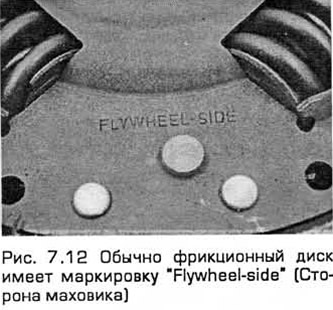
13. Install the clutch cover on the pins. matching labels (in the presence of) on the clutch cover and flywheel. Insert the fixing bolts and hand-tighten them until the friction disc is fixed but can be moved.
14. After that, you need to center the friction disc, so that when the engine is connected to the transmission, the splines of the input shaft of the gearbox enter the splines of the hub of the friction disc.
15. Centering can be done as follows. Insert a round rod or long screwdriver into the hole in the center of the friction disc so that the end of the rod rests against the center of the end of the crankshaft inside the tail bearing. If possible, use a blunt tool, and if using a screwdriver, wrap the tip with tape to avoid damaging the bearing surfaces. By moving the rod from side to side and up and down, achieve the centering of the friction disc. After removing the rod, visually check the centering of the friction disc hub relative to the circle formed by the petals of the diaphragm spring.
16. Another way of alignment using a special tool is more reliable and eliminates the need for visual inspection (see fig. 7.16.).
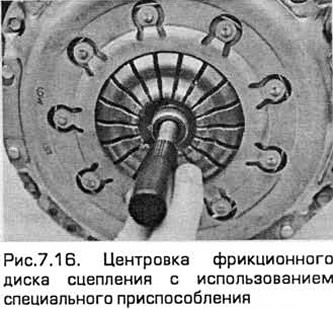
17. Torque tighten the cover mounting bolts in a criss-cross pattern.
18. Apply high-temperature grease to the input shaft pins and release bearing guide bushing.
19. Install transmission.
Visitor comments